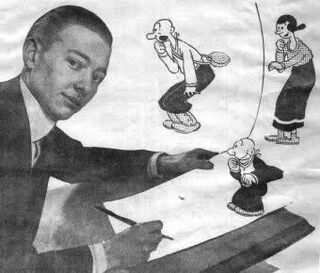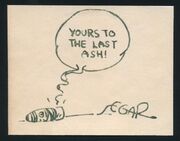
Segar in a 1920s ad for Thimble Theatre alongside the strip's then-main characters Ham Gravy, Olive Oyl and Castor Oyl
Elzie Crisler Segar (December 8, 1894 – October 13, 1938) was an American cartoonist, best known as the creator of Popeye, who first appeared in his newspaper comic strip Thimble Theatre in 1929. He was also the creator of the Sappo strip.
Segar was born and raised in Chester, Illinois, a small town on the Mississippi River. The son of a handyman, his earliest work experiences included assisting his father in house painting and paper hanging. Skilled at playing drums, he also provided musical accompaniement to films and vaudeville acts in the local theater, where he was eventually given the job of film projectionist. During this time, at age 18, he decided to become a cartoonist. He worked hard on a correspondence course in cartooning from W.L. Evans, of Cleveland, Ohio, in which he had invested $20. He said that after work he "lit up the oil lamps about midnight and worked on the course until 3 a.m."
Segar moved to Chicago where he met Richard Felton Outcault, creator of The Yellow Kid and Buster Brown. Outcault encouraged him and introduced him at the Chicago Herald. On February 29, 1916, Segar received his first full-time gig as a comic artist when he inherited the existing strip Charlie Chaplin's Comic Capers from its recently-deceased creator Stuart Carothers; the strip would continue under Segar for a year before its cancellation. After creating two further short-lived strips, And They Get Away With It and Barry the Boob, Segar moved on to Hearst's Chicago Evening American in 1918, where he created Looping the Loop, a vertical single-panel strip satirizing Chicago's urban culture and nightlife. Segar married Myrtle Johnson the same year; they had two children.
Managing editor William Curley thought Segar could succeed in New York, so he sent him to King Features Syndicate, where Segar worked for many years. He began by drawing Thimble Theatre, initially one of several replacements for Ed Wheelan's strip Midget Movies, for the New York Journal. The strip made its debut on December 19, 1919, and featured the characters Olive Oyl, Castor Oyl, and Ham Gravy, who, in varying configurations, would serve as the strip's leads for a decade. While initially failing to attract mainstream popularity, Thimble Theatre (particularly following its introduction of regular ongoing storylines in 1922) nonetheless gradually accumulated a modest following as the 1920s advanced, eventually receiving a Sunday strip in January 1925. In December 1920, Segar likewise debuted a second daily strip, The Five-Fifteen, initially centering on the exploits and dysfunctional marriage of the urban commuter John Sappo. Largely retitled Sappo the Commuter (or simply Sappo) by 1923, the strip would continue until its cancellation in February 1925, but would see resurrection a year later as a Sunday-only topper strip (now consistently renamed as Sappo) for Thimble Theatre; it would continue in this capacity until Segar's death.
Following years of middling success, Segar's fortunes experienced an exponential upturn in January of 1929 when Popeye, a weatherbeaten sailor hired by Castor Oyl to navigate the latter's ship to Dice Island in the midst of an ongoing Thimble Theatre storyline, gained substantial popularity among Segar's readership. The Popeye character "stole the show" and, through reader demand, became a permanent lead by the following year, compelling an increasing number of major newspapers to run Segar's strip. By 1933, Thimble Theatre, now partially retitled to promote Popeye's starring role, had exploded into a national success, producing a highly successful series of animated shorts and a plethora of merchandise; by the time of his death in 1938, Segar was resultantly earning over $100,000 (equivalent to approximately 2.16 million USD in 2023) a year. Thimble Theatre's secondary cast likewise expanded considerably during the 1930s to accommodate such notable characters as J. Wellington Wimpy, Poopdeck Pappy, Alice the Goon and Eugene the Jeep, while former leads Ham Gravy and Castor Oyl receded into guest roles or disappeared entirely.

Segar's signature
Asked how to say his name, he told The Literary Digest it was SEE-gar. [1] He commonly signed his work simply "Segar" or "E. Segar" above a drawn cigar. (At that time, the word "cigar" was often pronounced in the slangy way "SEE-gar" instead of the more proper "sih-GAR".)
Segar died of leukemia at the age of 43 in October 1938, following several months of illness; the final Thimble Theatre daily bearing his signature appeared on August 27, 1938, while his final Sunday strip appeared on October 2. Thimble Theatre (and, until its cancellation in 1948, Sappo) would be inherited by a succession of writers and artists in subsequent decades, the most prominent (and longest-tenured) of these being Bud Sagendorf, who had served as Segar's assistant from 1933 to 1938.
The National Cartoonist Society created the Elzie Segar Award in his honor.
Gallery[]
Sources[]
- ↑ Charles Earle Funk, What's the Name, Please?, Funk & Wagnalls, 1936.





